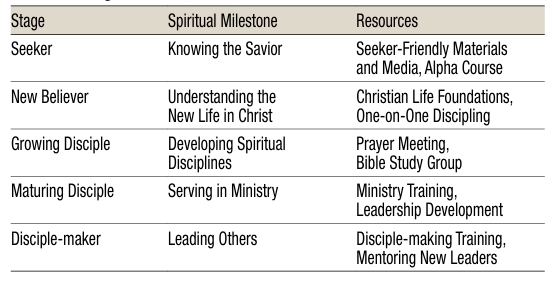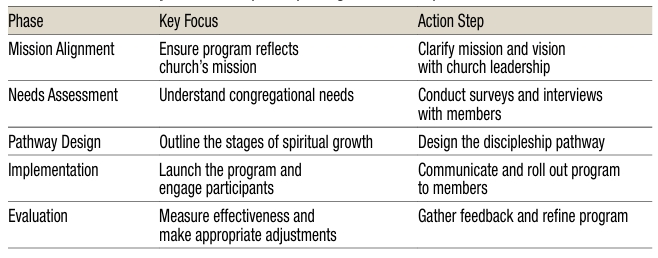Movement of Discipleship Key 3: Design an Intentional Discipleship Program
By Rev Matthew Lim, Emmanuel Church of Singapore

What are the considerations, steps and implementations you could work on when you design a discipleship program? Rev Matthew Lim gives us a detailed explanation.
Discipleship, which embodies Jesus’ Great Commission to “make disciples of all nations” (Matthew 28:19), is at the heart of the Christian mission. As such, an intentional discipleship program that aligns with the disciple making mission and developmental needs of one’s church, will foster not only spiritual growth among believers, but also the formation of a transformative Christlike community who will in turn win the pre-believers and disciple new believers.
This article, which outlines the key considerations and practical steps of designing an intentional discipleship program, and supported by examples, charts and applications for today’s context, could be useful for pastors or church leaders who hope to make disciple-making the sustaining emphasis of their churches.
The foundation of any discipleship program is its alignment with the church’s mission.
1. What Considerations?
a. Is the discipleship program in alignment with the church’s mission?
The foundation of any discipleship program is its alignment with the church’s mission. The mission defines the overarching purpose and direction of the church, and the discipleship program should reflect this unique calling, whether that be evangelism, community outreach, missions or another focus. Without this alignment, the discipleship efforts may lack coherence and thus fail to produce the desired spiritual growth and results.
For example, a church fervent in reaching out to the local community may design a discipleship program that involves training members in relational evangelism and practical ways to serve the neighborhood, besides updating regular opportunities to engage in community events or projects.
b. Does the discipleship program meet the developmental needs of the congregation?
Different churches have different developmental needs depending on their congregation’s demographic makeup, spiritual maturity and specific challenges. Understanding these needs is essential in designing a program which resonates with the members.
The chart below is a sample of an assessment of one’s congregational needs:

c. What kind of resources are needed to run the discipleship program effectively?
Effective discipleship requires resources—trained leaders, study materials, meeting spaces and financial support. Churches must assess their available resources and then plan accordingly. In certain cases, partnerships with other churches or mission organizations might be necessary to fill the gaps.
For example, our church, which is a smaller congregation with limited staff, in this next phase of our discipleship development, is partnering with other churches and Christian organizations, to access a broader range of discipleship resources, from mentors/coaches to video teachings.
d. Is the discipleship program flexible and adaptable?
The program should be flexible enough to adapt to changing circumstances, such as shifts in congregation demographics or external challenges such as a pandemic. It should allow for continuous evaluation and updates to ensure it remains relevant.
Example: Our church only had in-person small groups initially, but started an online group later, to accommodate members who cannot attend due to physical distance or health concerns.
A clear discipleship pathway helps members understand where they are and what their next stage of growth should be.
2. What Steps?
a. Develop a Discipleship Pathway
A clear discipleship pathway helps members understand where they are and what their next stage of growth should be.
Chart: Emmanuel Church of Singapore’s Revised Cyclical Discipleship Pathway

Note: Our church started with the progressive pathway of the 5Ms:
Membership, Maturity, Ministry, Mission and Magnification of the “Purpose-Driven Church” when discipleship was first implemented in 2018.
b. Outline Discipleship Progression
Outline clear steps for growth from a new believer to a disciple-maker. This progression should include spiritual milestones and resources for each stage.

c. Develop a Strategic Plan with Clear Objectives
• Define specific and measurable objectives for your discipleship program. For example: Increase small group participation by 10% in the following year.
• Application: Develop a strategic plan that outlines the action steps needed to achieve your discipleship objectives.
• The chart below is an example of a plan:

d. Provide Training and Resources
• Equip leaders and participants with the necessary tools and resources for intentional discipleship.
• Application: Offer training sessions, provide study guides, and recommend books and online resources.
• Currently, our church is using the “Omega Discipleship Series” by Ian Malins, which is available at SKS Bookstore.
e. Continuous Evaluation and Adaptation
• The effectiveness of a discipleship program should be regularly evaluated, and adjustments could be made based on feedback and changing needs within the congregation.
• Application: Conduct regular surveys or feedback sessions with participants to gather insights into what is working and what needs improvement. Introduce new topics for study or alter the format of meetings where appropriate.
Chart: Continuous Cycle of Discipleship Program Development

Designing an intentional discipleship program is an arduous and dynamic process that requires thoughtful planning, alignment with your church’s mission, a realistic understanding of your congregation’s needs, and flexibility.
3. What Now?
Implementation is key to the success of any discipleship program. However, discipleship is not a one-time event but an ongoing process. Therefore, consider the following for sustaining the program:
a. Integrate Discipleship into Church Life
• Ensure that discipleship is woven into church activities and events.
• Application: Intentionally include youths in the organizing committees of church events so that intergenerational friendships can be fostered, and mentoring relationships can be built.
b. Equip and Empower Leaders
• Invest in the development of current and future leaders who are passionate about discipleship.
• Application: Offer regular training sessions and workshops and go to conferences focused on disciple-making principles and practices together.
c. Celebrate Successes
• Publicly recognize and celebrate individuals and groups who are intentionally making disciples.
• Application: Share testimonies during services or in church newsletters about how discipleship or disciple-making has changed lives and deepened faith.
Designing an intentional discipleship program is an arduous and dynamic process that requires thoughtful planning, alignment with your church’s mission, a realistic understanding of your congregation’s needs, and flexibility. By considering the unique context of your church, and delineating intentional growth phases in your discipleship pathway, you can encourage an ecosystem where discipleship can flourish, and lead members toward spiritual maturity and reproduction of disciples.
The journey towards a disciple-making church is an ongoing kingdom endeavor, and with dedication and intentionality, it can lead to a vibrant community of disciples and disciple makers. Remember, the ultimate goal is to make disciples who in turn make disciples, perpetuating the Great Commission in your church and beyond.

Rev Matthew Lim is the Senior Pastor of Emmanuel Church of Singapore and an associate ordained minister with the Assemblies of God of Singapore. He has been serving the Lord for more than 20 years, with experiences in missions, pastoring, marketplace ministries, itinerant preaching and interpretation, and teaching at Bible college. He is married to Ruth and they have two children. He is presently doing a doctoral program with ACTS College-APTS.




